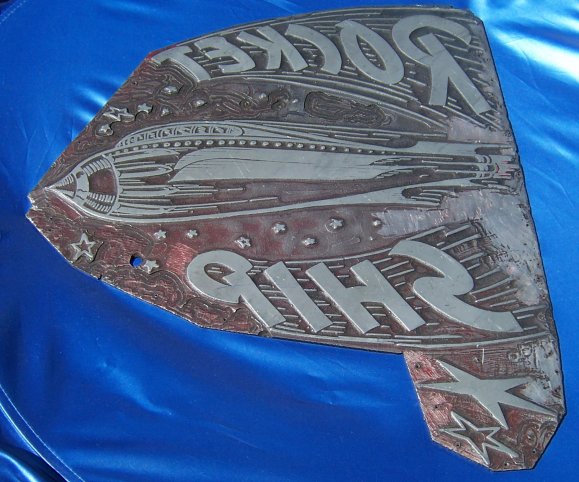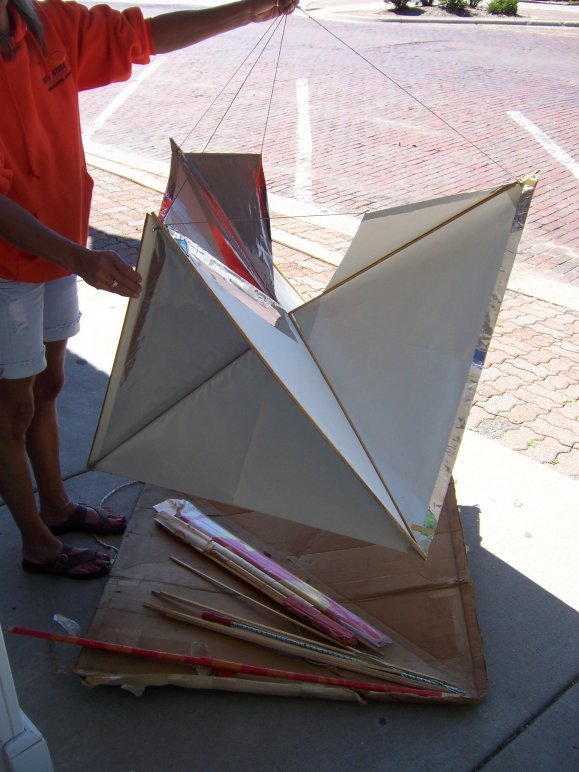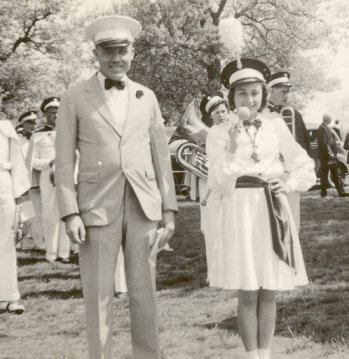|
|
|

|
 July
27, 2008: Alox Kites and Toys July
27, 2008: Alox Kites and Toys
 I've
had a little time to look at and photograph the material I received
from Nancy Frier a few days ago. (See yesterday's entry.) I've begun
work on a new Web article on Alox products and especially Alox kites,
but I can post some early photos. I've
had a little time to look at and photograph the material I received
from Nancy Frier a few days ago. (See yesterday's entry.) I've begun
work on a new Web article on Alox products and especially Alox kites,
but I can post some early photos.
At left is the "Rocket Ship" kite design, but it's not
printed from the plate I showed you yesterday. The text and the
spaceship are in different colors, indicating that they had separate
plates at some point for two-color printing. The kite is 30"
high and 24" wide, the same as Hi-Flier's Playmates of the
Clouds. The Rocket Ship kites were printed on four different colors
of paper, in either a single color or a two-color design. The catalog
number of this size of kite was #324. As best I can tell (and I
will ask Nancy about this) there was no specific SKU number for
a given design in a given size. Kites in this size were printed
two-up on sheets of paper 30" X 50" and then cut and trimmed
to the final diamond shape. The kite shown here is post-1964 because
the Alox patent #3,330,511 is printed on it. Alox did a big business
in promotional kites in this size. I have a few, and will photograph
them when we get back to Colorado.
Later on Alox sold a larger kite in a form factor I don't think
Hi-Flier or any other contemporary firm used: 40" X 40".
The one I have is in plastic, with a more modern Rocket Ship design.
This is size #420, and was sold in this design and an American Eagle
design, in several colors of plastic and ink. Most diamond kites
are a little taller than they are wide for stability (useful given
that most kids have no idea how to fly kites and learn by painful
experience) but bow kites in this proportion or even wider than
they are tall can be flown with only a little more skill. These
are called Malay
kites, presumably because their design originated in Malaya.

Alox also sold barn door kites and box kites. I have a couple of
the box kites and will post photos once I get back home and can
(carefully) assemble them for display. (One will need some careful
repair to the paper sail.) As best I know, Alox was unique in selling
a plastic box kite, which was dimensionally similar to the Hi-Flier
paper box kite—and probably a lot more durable.
Alox sold kite string pre-wound on hardwood dowels rather than
on cardboard tubes, as Hi-Flier did. Lengths included 200 feet,
250 feet and 700 feet. Early kite cord was the familiar cotton twine,
but in later years Alox sold a polyester fiber cord called "American
Eagle twine" that was much stronger than cotton, and similar
to Hi-Flier's Megalon. Other toys in the Alox line included yo-yos
of various designs (called "Flying Disks" to avoid the
Duncan trademark on "yo-yo"), whistles, sound-effects
whips, "carnival canes," jacks sets, Chinese checkers
boards, and many kinds of marbles. Their sales sheets are fascinating,
and once I scan them I will incorporate them in my upcoming article
on Alox.

Alox closed in good part because a lot of their bread-and-butter
items, especially toys, began coming in from China in huge quantities
in the 1980s. Anybody who gets the Oriental
Trading Company catalogs will know just what I mean here. You
can get plastic kites from China (I have a few, and they're in the
Oriental Trading catalog every spring) but they are lousy kites,
and diabolically difficult to fly. I still think that nothing has
ever beaten the 36" paper diamond kite in stability and "getting
up to speed" in young, inexperienced hands. Even with a sail
badly glued from newspaper, such kites went up enthusiastically
and practically flew themselves. It's a bit of a tragedy that diamond
kites have become rare (the ubiquitous deltas are cranky and in
my opinion hugely overrated) and a serious tragedy that paper kites
as a whole have become extinct.
They don't have to be. The sticks can be had at Hobby Lobby or
Michael's. The newspaper is in the recycle bin. Cotton twine is
at Home Depot, and Elmer's Glue will stand in for mucilege. What
are you waiting for?

|
 July
25, 2008: John Frier: American Inventor July
25, 2008: John Frier: American Inventor
I have a very popular Web
page devoted to Hi-Flier kites, and it generates more mail than
anything else on my site except Contra. A few weeks ago, I got an
email from Nancy Frier, introducing herself as the granddaughter
of John Frier, founder of Alox Manufacturing Co. of St. Louis. Alox
was one of three companies that mass-produced paper kites for the
toy market in the 20th century, the others being Crunden-Martin
(TopFlite) and Hi-Flier. I flew a few Alox kites when I was a kid,
but they were not available at Bud's Hardware, so I could only get
them when I was somehow at farther stores like Walgreen's or Kresge's.
Nancy had seen my Hi-Flier page (which mentions Alox kites briefly)
and offered to provide more information on Alox and the remarkable
man behind it. Earlier this week, I took advantage of a fluky chance
to meet her while she was traveling from Wisconsin to St. Louis,
and we lunched outside of Rockford.
Whoa. I've been at some interesting lunch meetings in my time (and
I've had breakfast with Isaac Asimov and dinner with Steve Ballmer)
but this one was amazing. Almost all my information about Hi-Flier
is second or third hand. Nancy was there. She had worked
at Alox since she was a teenager. She actually made the kites, and
by "made" I mean that literally: She fed sheets of paper
and plastic into the special printing presses, and pushed the buttons.
She worked the jig that stretched out a diamond of waxed string
over the cut kite sails, and then folded and glued the edge tabs
of the sails over the string. (This last machine was Frier's own
invention, and he held patent
#3,330,511 on it.) She worked for Alox until the company folded
in 1989. She still has the copper letterpress plates from which
Alox kites were printed, and she had one in the back seat to show
me. (Below; photographed on her car window sun-screen.) And before
she continued on to St. Louis, she handed me an armful of Alox kites,
some of which dated back to the early 1950s. The kites were much
appreciated—and I'm working on an article about Alox kites—but
what really made the meeting was hearing about John Frier himself.

Born in 1895, Frier had a restless mind, of the sort that demands
to know how things work and constantly tries to figure out better
ways to go about them. He was fascinated by things that flew, and
in 1911, when he was 17, he built an airframe with a wingspan of
about 20 feet in his parents' shed outside of St. Louis. He called
it a glider, but it was clearly built to accept an engine (she showed
me photos) and it was certainly large enough to carry a pilot. Way
cool—but then she pulled something else out of her briefcase:
A letter to John from the chief counsel of the Curtiss Aeroplane
Company, which threatened poor teenaged John with a patent lawsuit
unless he ceased making flying machines that infringed on several
unspecified Curtiss patents. Frier ignored the letter, but the following
year the shed caught fire under mysterious circumstances and took
the plane with it, all before John and one of his friends could
complete and launch it.
John Frier served in WWI, and when he got home he returned to his
main business of having ideas. One of them was a way to keep shoelaces
from unraveling at the ends. Although other things had been tried,
Frier's method looks a great deal like the stiff plastic ends you
see to this day. (His were made of thin metal.) He obtained patent
#1,318,745 in 1919, and created a company to manufacture and
sell shoelaces. He named the company Alox because it was different
from all other local manufacturing concerns in St. Louis—and
would be right at the front of the phone book, which at that time
was more of a phone pamphlet. Alox cranked out shoelaces for decades,
and at least until WWII it was their core product line.
Soon after founding Alox, Frier began manufacturing and selling
paper and later plastic kites for children. Nancy gave me a great
deal of information and photos concerning Alox kites, but I don't
have a scanner here with me and can't show you anything right now.
I'll be doing a detailed article on Alox kites once I get back to
Colorado, so stay tuned.
Alox is actually better
known among marble collectors than kite collectors. Frier liked
making toys, and in addition to kites Alox manufactured yoyos, jacks
sets, jump ropes (which, after all, are basically large shoelaces
with wooden ends) and Chinese checkers sets. At first he bought
the marbles for Chinese checkers on an OEM basis from other companies
whose sole business was marble manufacturing, but the common practice
of bringing a box of marbles "up to weight" by throwing
in pieces of broken glass enraged him. He bought several marble-making
machines from one of his former suppliers and began making the marbles
himself, at first for his Chinese checkers and Tit Tat Toe games,
and later as a separate product line. The marble machines were crude
(and incorporated mechanical oddities like transmissions from 1920s
Hupmobiles) but John and his staffers slowly improved them, and
he soon pretty much owned the US marble market. He bought cullet
glass from glass manufacturers to melt into marbles, but also bought
empty glass bottles in various colors on the scrap market and melted
those as well. (Alox's blue marbles had mostly been Milk of Magnesia
bottles.) The machines ran 24/7 because it took several days and
a lot of fuel oil to bring a batch of glass to full melt, and when
John Frier shut down marble production in the late 1940s, it was
mostly because keeping a marble factory running all the time was
a nuisance. He was the CEO, but he was also the only guy who could
troubleshoot the cranky marble machines, and he liked to sleep at
night undisturbed by frantic calls from his foremen.

Nancy's final revelation about the Alox product line was the most
fun of all: John Frier and Alox made UFOs. Shortly after WWII, Alox
got the contract to construct balloon-borne radar targets for the
Army Signal Corps. Alox had built thousands of ML307C/AP
target devices, starting in early 1947. One of the most famous
late-40's "UFO debris" photos clearly
shows an ML307, as vehemently as the UFO gang has tried to deny
it. Nancy had an Alox-built ML307 target in the back seat, and it
was a difficult thing to photograph well, especially in a parking
lot. It has a lot in common with a box kite, in that it's a corner
reflector designed to fold flat.
I'm running on longer than I generally allow myself in this space,
but it was great fun and a wonderful look at a period in American
history when almost anything was possible. Nancy handed me a lot
of material, and once I get home and get an article put together,
I'll link to it here. The kites are much too old to fly (obviously)
but they will take a place of honor on my workshop wall, along with
the Hi-Fliers already hanging there. Nancy is considering printing
and making reproduction Alox kites from the original copper plates,
if she can find suitable paper and a press that can do the job.
(I know very little about letterpress printing and can't help much
there; if you have suggestions I think we'd both like to hear them.)
I've been hoping for years that someone would begin making paper
kites for the nostalgia market, and with any luck we may still get
there. More as I learn it.

|
 July
21, 2008: LOLMonsters July
21, 2008: LOLMonsters
 We
were just BSing a couple of nights ago over wine and beers at Julie's
christening, and LOLCats
came up. I'm not a regular reader of LOLCats, but I've seen it enough
to get a sense for the genre, and the addition of a little zinfandel
reminded me that this is not a new thing. We
were just BSing a couple of nights ago over wine and beers at Julie's
christening, and LOLCats
came up. I'm not a regular reader of LOLCats, but I've seen it enough
to get a sense for the genre, and the addition of a little zinfandel
reminded me that this is not a new thing.
Nossir. I remember Monster Cards.
Back in 1961 or 1962, a fad was raging in my corner of the Immaculate
Conception grade school playground: Monster cards. These were a
little like baseball cards (and about the same size) but instead
of sports heroes, they had stills from old monster movies, with
a silly caption at the bottom. This was in plain English and not
LOLCats-speak (which itself
is a parody of IM shorthand) else the card at left would be captioned
PUT ME ON UR FRENZ LIST? On the flipside was a drawing of a ghost
over a joke calculated to make fourth-graders laugh. (As you might
imagine, the bar was not very high.) The whole thing was wrapped
up in plastic with a card-sized rectangle of some tepid and invariably
stale bubble gum. My friends were all collecting them, and even
though I spent my money on Hi-Flier kites and Tom Swift books rather
than monster cards or comics, I flipped through my friends' stacks,
grinning at some and rolling my eyes at others.
There were two types that I remember, both available from Perlen
Drugs at the corner of Canfield and Talcott. The larger cards had
"Spook Stories" printed on the back and were copyrighted
by Universal Films. These had the most famous and recognizable monsters:
Frankenstein, the Mummy, the Creature from the Black Lagoon, and
the Wolfman. The jokes on the back were sometimes even clever. The
smaller cards had "Monster Laffs" printed on the back
over the jokes (which were invariably stupid and rarely funny) and
were printed in sheets of three with bad perfs between them. My
duller friends who didn't catch on to folding at the perfs before
separating them often had to Scotch tape their cards back together
after inadvertently ripping them in half. These smaller cards (which
collectors have dubbed "Monster Midgees") were copyrighted
by cheapo fright house American International Films, and apart from
the several incarnations of the She Creature and the memorable Colossal
Beast, showed monsters that few of us had ever seen, even with Chicago
Channel 7's perpetual scraping of the bottom of the monster movie
barrel. Mostly they were hokey-looking paper mache alien things
or brains with eyes, over even hokier (and generally un-funny) captions.
I'm surprised at how little there is online today about monster
cards, at least the ones that I recall. The genre continued long
after I left grade school, mutating as it went, but I ignored them
because they dropped the humor. The legendary Mars
Attacks! cards were in no way funny; in fact, they were a gruesome
comic book presented one frame at a time. (I wonder sometimes if
they were a poke in the eye of the Comics Code Authority.) Cards
from mid-60s TV series like The Outer Limits and Star
Trek had stills from the shows but no funny captions and no
jokes—and sheesh, guys, I had already seen the TV shows. I
half-expected full indices of the cards and their captions online,
but apart from a
few fan pages and pictures of cards for sale on eBay, they've
mostly been forgotten. "Caption humor" seemed to go into
eclipse for forty years, not to emerge until the Internet Age and
LOLCats. I guess everything comes back eventually. I used to wear
purple bell-bottoms and
worse in the late 60s and early 70s. Are they next?

|
 July
20, 2008: Juliana's Christening July
20, 2008: Juliana's Christening

After much planning and preparation, our new niece Juliana Leigh
Roper officially joined the Catholic community last night, as all
of the immediate family we have left gathered around Bill and Gretchen's
huge dining room table for the Mass and baptism. Rev. Mary of the
Old Catholic Church presided, as
she did back in December 2006 for Julie's older sister Katie Beth.
Once again, Gretchen hand-made a christening dress for Julie, and
Carol gave Julie the little christening shoes that she herself had
worn back at her own baptism in 1953. Again as for Katie Beth, Carol
and I promised to keep her on the path as best we can. Godparents
don't have to be theologians; what they have to be are good examples
and good cheering sections. Carol and I had excellent
godparents, and the example was not wasted on us. And yes, words
are my thing and I am going to attempt a simple catechism for small
children, but we're a couple of years off on that yet. (Which doesn't
absolve me from starting to take notes right away. Kids grow up
fast.) Theology for ten-year-olds can start very simply,
and I will begin with what I learned from Juliana's namesake: Lady
Julian of Norwich, who taught that God is infinitely loving and
forgiving, and that all manner of thing would ultimately be made
well in God's own time. Sooner or later, children must also learn
that that there is death and suffering and injustice, but those
lessons must be learned from a platform of solid belief in the goodness
of creation and God's ultimate victory over all evil and suffering.
The goodness of that creation and God's affection for his creatures
was the subject of Mary's short homily from the head of the dining
room table. Partway through, Julie began to fuss a little, in the
time-honored tradition of infants making a ruckus in church. Without
missing a beat, Mary scooped little Julie up in her arms and calmed
her down as only a mother (and grandmother) can, continuing to preach
her sermon with a baby on her shoulder. (This is something you don't
generally see in Catholic churches.) Julie soon returned to sleep,
and barely stirred when Mary took the seashell and poured the (warm)
blessed water over her forehead, baptising her in the name of the
Father, and of the Son, and of the Holy Spirit.
Afterward there was time for good talk, good wine (we had a Frey
organic zinfandel and a Bartenura moscato) and Bill's superb grilling
skills, with fresh Polish sausage and hamburgers, Hawaiian salad,
baked beans, and various small sides. QBit and Aero ran around in
circles in the back yard while Katie watched, laughing with delight,
and even though the evening was muggy and drippy, Carol and I called
it a complete and unvarnished success. Come 9:30 we packed up the
puppies and headed for the door, but Katie cried and kept reaching
for Carol, who had read her One Fish, Two Fish, Red Fish, Blue
Fish several times. Earlier, she had been brushing what's left
of my hair with her new hairbrush. She is beginning to learn about
godparents and their uses, heh.
After a pretty grim ten years or so on the family front, family
is happy and growing again. For many years Gretchen and I thought
that our part of the Duntemann line ended with us, but God sometimes
answers prayers, and midevening, when our two little prayers sat
together in the big chair for pictures, somehow we knew that All
Manner of Thing will be well—in fact, as far as we're concerned,
we're most of the way there right now.


|
 July
18, 2008: Odd Lots July
18, 2008: Odd Lots
- I'm not quite as ga-ga as the reporter, but make no mistake:
This
is one of the most startling deep-space videos ever taken,
of the Moon making a transit across the Earth, seen from a distance
of fifty million kilometers. Thanks to Pete Albrecht for the link.
- My nephew Brian just bought a Blackberry cellphone and is trying
to find a software package that will allow him to sync his Google
Calendar data with the phone. This is something I've never had
to do (I do not currently have a PDA nor a smartphone) and so
I'm looking for suggestions.
- Eat kohlrabi, Dean Ornish: A
long-term study published in the New England Journal of Medicine
indicates that low-carb diets are significantly better at helping
people lose weight and lower cholesterol than low-fat diets. As
complex as the obesity issue is, I speak to people again and again
and again who have found what we've found in their own lives:
Lowering fat does not help much. Lowering carbs, and especially
lowering sugar, helps a lot.
- Carol and I were down in Lincoln Park the other day, and saw
saturation advertising for a wind-powered condo complex that intrigued
me enough to write the Web address down across Heath Ledger's
late face on the Red Eye. Take
a look and read the fine print. Those well-hidden wind turbines
on the roof generate up to 2% of the building's electricity.
And so wind power takes its place as a techno-fetish among the
terminally hip and the gorgeously clueless. Larger turbines could
generate significantly more of the building's power, but the
neighbors might complain—and that's not hip at all, is
it?

|
 July
16, 2008: Odd Lots July
16, 2008: Odd Lots
- A reader wrote to tell me that I am "MSG blind," (see
my entry for July 14, 2008) which means
that MSG does not affect my taste chemistry—and that people
who are MSG blind are generally the people who react badly to
the chemical. Alas, I can't find anything about this online, but
it's an interesting idea.
- Screw the polar bears. The big downside to Global Warming™
is now kidney
stones. Ouch.
- I hadn't heard much about the Casimir Effect recently, but courtesy
Frank Glover, here's a good article on modifying
nanoscale structures to minimize "stiction" due to Casimir
forces. More speculative but lots more fun are some links
at the end describing projects attempting to harness Casimir forces
in various ways, many or most of which still seem a little whiffy.
(I made enthusiastic use of vacuum energy in my novel, The
Cunning Blood.)
- The Washington Post suggests that we strap
engines on the ISS and send it to the Moon, to act as an orbital
station to help stage travel to a lunar base. Maybe a little far
fetched, but only a little—and we're not doing much with
the damned thing where it's sitting right now.
- And as if NASA didn't have enough to worry about, now, well,
scientists are telling them that they had better establish an
officially sanctioned 200-mile-high club.
- The acronym is unfortunate, but Sandisk's
write-once read-many (WORM) SD card has an application that
isn't even mentioned in the press release: A unit for mounting
a hack-proof operating system instance. No mention what the access
time is (I'm guessing slowwwww) but it's an approach that many
people have been calling for for some years.
- Finally, as a proud godfather of two nieces who are big for
their ages but still very small, this
video made me cringe a little. (Don't parents have enough
to worry about?) Quick, how long would it take you mechanical
engineer types to devise a sheet-metal flap valve to fix this
problem?

|
 July
15, 2008: Crackergate, Mon Dieu July
15, 2008: Crackergate, Mon Dieu
I elbowed a bit of a wasp's nest yesterday, in briefly recounting
the story of Paul Z. "PZ" Myers, the biology professor
who put out a call for Catholics to mail him consecrated hosts for
public desecration. There's backstory that fairness requires me
to relate: Webster Cook, a student at the University of Florida,
went to Mass at a Catholic Ministries liturgy held on campus, took
Communion, and went back to his pew without consuming the host.
Why he did this is unclear—I had a great deal of trouble sifting
facts from hearsay in this case, which exists mostly in the blogosphere—but
he took the host out of the building even though some of the people
from Campus Ministries noisily demanded that he either swallow it
or give it back. He refused, and the host went home with him in
his pocket. Thus began...Crackergate.
I may catch some flack here from my Catholic readers for saying
this: The church should have left it at that. But no, the well-known
William Donohue, head of the Catholic League, got into the act,
and suddenly it's a category 5 barroom brawl. Donohue has made a
career of jumping on anybody and everybody who says something that
puts Catholicism in a bad light. How effective he's been is open
to debate. He was certainly instrumental in getting ABC's warm-hearted
but liberal-slanted Catholic sitcom Nothing Sacred canceled
back in 1997; beyond that it's hard to tell. He's gone after solid
milk-chocolate statues of Jesus and tried to organize a boycott
of the film version of The Golden Compass. I'd suggest that
there are other, better places where that sort of energy might be
spent, but let it pass. Most moderate Catholics would love to find
another village that would take him.
Webster Cook returned the undamaged host to the church about a
week later, but not before the Catholic lunatic fringe had begun
sending him death threats. And then Prof. Myers jumped into the
game, eager to play the dozens and keep the pot at a full boil.
Here are his exact words, posted on his blog:
I have an idea. Can
anyone out there score me some consecrated communion wafers? There's
no way I can personally get them — my local churches have stakes
prepared for me, I'm sure — but if any of you would be willing
to do what it takes to get me some, or even one, and mail it to
me, I'll show you sacrilege, gladly, and with much fanfare. I
won't be tempted to hold it hostage (no, not even if I have a
choice between returning the Eucharist and watching Bill Donohue
kick the pope in the balls, which would apparently be a more humane
act than desecrating a goddamned cracker), but will instead treat
it with profound disrespect and heinous cracker abuse, all photographed
and presented here on the web. I shall do so joyfully and with
laughter in my heart. If you can smuggle some out from under the
armed guards and grim nuns hovering over your local communion
ceremony, just write to me and I'll send you my home address.
Here's the
full post on Pharyngula.
Ok. Does any of this sound to you like a pack of seventh graders
mixing it up on the playground? It sure does to me. The detailed
facts seem to change depending on whom you read, but Cook is claiming
that he was "restrained" by a woman who turns out to be
about half his physical size. He is now filing charges against the
Campus Ministries for violating university hazing rules that prohibit
forced eating. And Bill Donohue is trying to get PZ Myers fired.
So far, as best we can tell, no desecrations have taken place.
My primary comments on all this:
- Genuine death threats are illegal and actionable. If you get
one, don't just bitch. Go to the cops. That's what laws are for.
- If your opponents are insulting you, meeting them insult-for-insult
is precisely the wrong thing to do if you want the moral
high ground, or to simply avoid looking stupid.
- Respect is an inner virtue; less something you show than something
you are. Desecration happens in the man (or woman)
and not to the host, flag, book, shrine, or image.
- Allowing people to make you angry gives them power over you.
Atheists who are cheering on Myers seem blind to the fact that
Myers is making atheism look bad. Which leads me to ask: What is
atheism actually for? If its goal is to win people away from
religion, making sane arguments in a respectful manner would seem
more effective than insults and ridicule. If (as seems to me at
times) it's a sort of tribal venting society, then go for it, keeping
in mind that few people recognize therapeutic venting for what it
is, and you won't get a lot of converts from ordinary folks who
are not axe-grinders by temperament. You'll just look churlish.
I'm sure I've already given this more attention than it really
deserves. I've begun wondering if Webster Cook was challenged over
a drink to come up with the college prank to end all college pranks
(judged by the ratio of effort required to publicity generated)
and he may have succeeded. I've also heard that PZ Myers is considering
desecrating a copy of the Qur'an as well. I'll believe that
when I see it.

|
 July
14, 2008: Odd Lots July
14, 2008: Odd Lots
- For a little over a year, I've been buying dry-roasted peanuts
from Safeway that do not contain MSG. Recently we noticed that
the packaging had changed, and checked the ingredients. MSG returns,
gakkh. Dry-roasted peanuts are a much better snack than their
rep would have it, but MSG makes me feel weird in the head, so
the search for MSG-free dry-roasted peanuts resumes. Interestingly,
I had a couple of Planter's dry-roasted peanuts the other day
(knowing full-well that they have MSG in them; I had a few, not
handfuls) and they do not taste any different. Not better.
Not worse. Not a little bit. Not at all. So the companies
that print "monosodium glutamate (flavor enhancer)"
on their peanut labels are being ripped off. MSG does not enhance
flavor. What it does do is mess some people over (like me, and
countless others) and cost the vendors money. MSG is cheap, but
not free. When will food packagers realize that they could save
money and increase their market by just dumping it?
- Pertinent to the above, Jay's Barbecue Potato Chips also lack
MSG, and are the only barbeque potato chips I've ever seen that
don't have it. They are a Chicago brand, and so far we haven't
seen them in Colorado Springs. But when I'm here, I gorge.
- I'm a big fan of lashup railcars, but I startled a little when
Pete Albrecht sent me a link to a model of a
pink Galloping Goose. The paint schemes are described
as "authentic." So was there ever a Rio Grande Goose
in pink and white livery? I've not been able to determine that—but
whoa, somehow I doubt it. That's a spit-and-baling-wire, real-man's
tin-roof rough-and-tumble item that reminds me of Mad Max
as much as it does of the Old West. Pink? Sheesh!
- A tenured professor at the University of Minnesota has put
out a call for Catholics to send him consecrated Eucharistic hosts...so
that he can desecrate them. I had hoped this was an urban
legend, but the Washington Times generally knows better.
I wonder if he (and his clueless university) understand that this
doesn't hurt the Church at all, but makes higher education in
general and university professors in particular look mean-spirited
and ridiculous.
- From Michael Covington comes a link to a
Modern Mechanix item from 1933 that may be the original "watt
dog" cooker, which spawned a
famous Carl & Jerry story cautioning young tinkerers about
the hazards of messing with line current. A board with nails pounded
through it, facing up...with 110V on the nails. Wow. (And while
you're there, click on the cover image to get a closer look at
what was prompting young geeks to buy magazines in 1933. Maybe
the
Flynn Effect really does exist.)
- On second thought, probably
not.
- Thanks to Baron_Waste,
I discovered that the
United States' net carbon emissions declined by 3% between 2000
and 2006. Of the top 17 carbon emitters, only France reduced
emissions more—and I'd wager that that's because France has
had the good sense to stuff their antinuclear crackpots in the
Bastille and forget about them.
- Nertz. Wrong. France closed the Bastille in 1789. Well, hey:
Today is the
158th birthday of the ice maker.

|
 July
11, 2008: Rant: Idealism and "Settling" July
11, 2008: Rant: Idealism and "Settling"
I catch a certain amount of shit for my longstanding conviction
that idealism is a Bad Thing. (I just got another nasty email on
the subject, hence my very bad mood this evening.) The reason is
simple: Idealism consists of demanding the impossible—and
the human response when the impossible predictably fails to appear
is to throw various kinds of temper tantrums, from looking like
an idiot to making other people miserable up to and including imprisoning
and killing those who fail to conform to your personal idealisms.
I've read of this happening back into history as far as the eye
can see, and it boggles me that in the 21st century we still idealize
idealism.
An issue or two ago, The Atlantic ran a wonderful article
that sheds some light on the issue. In "Go
Ahead, Marry Him!" NYC overachiever Lori Gottlieb finally
endorses what some women dismissively call "settling;"
that is, marrying a man who is something less than precisely what
they demand, which is usually rich, brilliant, gentle, pliant, egalitarian,
and unerringly able to incite sexual passion every weekend for the
rest of their lives. As Lori tellingly puts it:
Unless you meet the
man of your dreams (who, by the way, doesn’t exist, precisely
because you dreamed him up), there’s going to be a downside
to getting married, but a possibly more profound downside to holding
out for someone better.
Well, duhh. The downside to perpetually holding out for someone
better is the possibility of spending your entire life alone, cursing
all men because they refuse to conform to your fantasies. This sort
of mental illness is not limited to women. I knew a guy in college
(of average looks, smarts, and ambition) who flatly refused to date
any woman who did not "look like a Playboy centerfold."
(Those were his precise words.) He finally and recently married,
in his early 50s, and his spouse is bright, funny, and warm. However,
I doubt she was ever Playboy material, even in her 20s. Figuring
it out late is better than figuring it out never. But had he figured
it out early, he might have had a lot more fun and been a lot less
lonely for a lot more years.
Life is about settling. All of life, all the time. Life's circumstances
are graphed on a complicated set of curves, and we can either calculate
the minima and make the best of it, or we can rage against the shape
of reality, and make things even worse while blaming those who do
not share our idealisms. Churches and political tribes are aces
at this. Conservative religions (Christianity being only one, but
the one we know best in the West) have a peculiar obession with
sexual idealism. Roman Catholicism condemns both abortion and preventive
birth control, because these do not conform to a complicated and
ancient sort of moral idealism that in essence demands that people
be sexless beings except when they're married and willing to conceive
a child. Endorsing birth control would reduce the number of abortions,
but that would be settling for less than the ideal. And so hundreds
of millions of people defy Church teachings or even leave the Church
entirely, and the abortion rate remains appalling. In refusing to
settle for the achievable, the RCC has held out for the impossible
and reaped catastrophe.
Idealism's prints are all over the political realm. We could end
gun violence by eliminating guns, so the ideal goes. But by only
eliminating some guns, we make gun violence worse. Crisp
gun laws that define legal use and training people in their legal
use would not end gun violence, but it would probably minimize
gun violence. I'll settle for that. Idealists will not. Idealists
tell us that if we would all just take public transportation, live
in the nasty little coffins that some call New York studio apartments,
and give up air conditioning, we would have neither global warming
nor an energy crisis. Whether or not the math actually makes sense,
you have to say, Well, good luck with that.
Marxist idealism, of course, has been the greatest murder-generator
in all of human history. To pragmatists this is common knowledge;
to idealists it's a heresy that they can never accept. There's not
a lot of benefit in belaboring the point. The two sides are not
even talking.
My objection to idealism cooks down to this: Idealism refuses to
consider embracing lesser evils and thereby generates greater evils.
We can argue about the identity of the lesser evils. We can argue
about whether the lesser evils are in fact evils at all. (Many are
not.) We can argue about whether embracing a lesser evil will in
fact minimize a greater evil. (This is not always the case.) But
idealism refuses to engage in the debate. That would be settling.
And there's no point in settling for less than the ideal, right?

|
 July
9, 2008: The Conundrum of AVG LinkScanner July
9, 2008: The Conundrum of AVG LinkScanner
Just before we left Colorado, and after several weeks of furious
nagging by the software, I upgraded version 7.5 of AVG Free Anti-Virus
for the new V8. I did it on Carol's machine only, as the upgrade
required some damned thing or another that was missing on Win2K
SP4, and I didn't have time to research it. (Carol uses XP.) With
version 8 came something I had not heard about and did not expect:
AVG LinkScanner.
It's an interesting idea, and at first glance sounds like something
truly useful: LinkScanner works with Google and Yahoo to prescan
search results for evidence of malware injection. At a rate of 2-20
results per second, LinkScanner visits each displayed search result
link, looks at what's on the other side, and displays one of three
icons to the right of the search link: Good, questionable, or bad.
I didn't even know the feature was present until later that day,
when Carol was doing some Google work and asked me what the icons
were. All were a reassuring green, but when I Googled on "warez"
almost all of the search results came back with icons of alarming
red.
This seemed reasonable to me, and I was too frantic getting ready
for our trip to think too deeply on it. But a few days later, I
started to run across Web articles howling
about an avalanche of Web hits spawned by LinkScanner. The Register
provides one
of the saner descriptions of the issue. Traffic on some smaller
Web sites has spiked by 80%, and Slashdot says that as much as 6%
of its massive clickthrough comes from LinkScanner's user agents.
LinkScanner, it seems, tries its best to look like an ordinary
user. Well, duhh: If LinkScanner's probe announced its presence,
malware artists would serve up an innocuous version of their sites,
keeping the malware for ordinary Web surfers who could be discerned
as such. I can understand the logic, but given that AVG has as many
as seventy million users worldwide (few of whom have yet upgraded)
widespread adoption of the technology could make ordinary Web traffic
analysis meaningless. Traffic on duntemann.com started rising about
April 1, but I couldn't quite figure what was going on. May was
a record month for me, even though my traffic has been fairly steady
since I launched my
LiveJournal mirror of Contra in early 2006. Things leveled out
in June, but given the proportion of my traffic that now reads Contra
on LiveJournal, I would expect aggregate traffic on duntemann.com
to be falling slowly.
Having had a little time to think about this, I can raise a couple
of points:
- AVG has not made it entirely clear what its probe looks for
when it prefetches search results. A site tagged as "safe"
might not actually be safe—especially once the bad
guys reverse-engineer the probe and figure out how to dodge it.
People might trust the utility a little too much, and assume that
there is no possible downside to visiting a green-tagged site.
- Obviously, AVG actually visits all sites in a search results
list, even those most users would shun as obviously dicey. If
the bad guys discover an exploit in AVG's probe, AVG could unwittingly
become the world's largest malware installer.
- The probe does not mask or alter the user IP in any way. As
far as remote site logs are concerned, the local user clicks
on every link in a search results list. Meditate on that for
a moment, and then read this
article from Slashdot. If you're not at least a little freaked
out yet, read it again.
I'm going to uninstall the feature on Carol's machine when we get
home, and may try one of the alternative lightweight AV products
like Avast,
especially since AVG Free V8.0 barfed on my main Win2K machine.
I've begun to see indications that AVG is patching V8.0 so that
LinkScanner is not enabled by default, but haven't gotten anything
crisp enough to link to. Supposedly, the patched version becomes
available today. We'll see. In the meantime, spidering sites with
some sort of malware-detection probe may not be as good an idea
as it seems on the surface. Better, perhaps to completely sandbox
or virtualize the browser, which would be better protection at a
bandwidth cost of...zero.

|
 July
8, 2008: Almost Done with Souls in Silicon July
8, 2008: Almost Done with Souls in Silicon
 We
got back from Wisconsin yesterday, having had a very good time getting
soaking wet and eating perhaps a little too much. I had forgotten
how pretty that part of the country was, even though my family went
there often in the early 1960s. It was where my mother grew up,
between the
little whistle-stop of Shennington and the larger town of Necedah.
(That's her at left, as Necedah High School's drum majorette in
1942, posing with her band teacher.) Carol and I explored the area
a little bit while we still lived in Chicago, but that's been thirty
years now, and it would be worthwhile to go back and hit Baraboo,
Mauston, Mill Bluff State Park, and a number of other places we
remember less well than we'd like. We want to return to Perot State
Park along the Mississippi, where I proposed to Carol in 1975, as
well as nearby Wyalusing. Next summer, fersure. We
got back from Wisconsin yesterday, having had a very good time getting
soaking wet and eating perhaps a little too much. I had forgotten
how pretty that part of the country was, even though my family went
there often in the early 1960s. It was where my mother grew up,
between the
little whistle-stop of Shennington and the larger town of Necedah.
(That's her at left, as Necedah High School's drum majorette in
1942, posing with her band teacher.) Carol and I explored the area
a little bit while we still lived in Chicago, but that's been thirty
years now, and it would be worthwhile to go back and hit Baraboo,
Mauston, Mill Bluff State Park, and a number of other places we
remember less well than we'd like. We want to return to Perot State
Park along the Mississippi, where I proposed to Carol in 1975, as
well as nearby Wyalusing. Next summer, fersure.
We're still in the Chicago area (currently in Crystal Lake) but
this trip isn't entirely vacation, and I'm pushing hard to get some
work done. Today was productive: I finished laying out and proofing
the body of Souls in Silicon, the first of two collections
I am preparing of my own SF. Souls in Silicon contains all
of my published stories pertaining to strong AI, including "Guardian,"
which was on the final Hugo ballot in 1981, and "Borovsky's
Hollow Woman," my 1983 collaboration with Nancy Kress, which
originally appeared in Omni. Other stories in the 9-story
lineup include "The Steel Sonnets," "Silicon Psalm,"
"Bathtub Mary," "Marlowe," "STORMY vs.
the Tornadoes," and "Sympathy on the Loss of One of Your
Legs." The collection will conclude with an excerpt from my
2005 novel, The
Cunning Blood.
With the body done and the page count frozen, I can get to work
on a cover. I commissioned custom cover art from Richard
Bartrop, and just approved his final color concept sketch. By
the time Richard is done, I should have a cover to drop the art
into, and we'll have us a book. Richard is very well-known in Furry
circles, but he's actually a formidable hard SF artist, and the
concept, from my story "Guardian," is terrific. Bodies
are easy. Covers are hard. My mother was an artist, but I think
she left her talents in Wisconsin; neither Gretchen nor I inherited
them. I hope to have copies to show around at Worldcon in Denver
this August, but that means I had better get to work.

|
 July
5, 2008: Sploosh! July
5, 2008: Sploosh!

We're at the Chula Vista Resort in the Wisconsin Dells
for a short family vacation, and I think I've identified the first
significant cultural contribution of the 21st century: the large-scale
water park. I'm not talking about a pool with a single slide, or
even two slides. I'm talking about a fifteen-acre indoor/outdoor
complex with twelve separate water slides, some easily fifty feet
high, with coils of people pipes that go outside the building and
then come in again, some in several different loops. One slide even
has a Men In Black 2 style "flusher" at the end. There
is a sort of aquatic roller-coaster-in-a-garden-hose, and a short,
simple flume that pretty much drops you vertically for about thirty
feet. I looked around, and I boggled—but then I started having
fun.
It's a species of fun that simply didn't exist when I was a kid.
We were delirious to have a simple swimming pool or even a muddy
lake to paddle around in. I think I frst saw a water slide when
I was thirty-five. And I have never seen anything even remotely
like this. There is constant motion (much of it from incalculable
numbers of eight-year-olds) and water pouring, squirting, and spraying
everywhere, in every direction at once. Buckets of many sizes, from
a gallon or two up to a multihundred something the size of a hot
tub, slowly fill while on pivots, and when the buckets fill, they
tip over and dump their loads on anyone who happens to be below.
There's a zero-depth baby pool, a one-foot deep toddler pool, a
four-foot-deep activity pool for preteens, a hot tub for exhausted
old guys, and a very interesting thing called a "lazy river,"
which is a linear pool about two feet deep and eight wide, propelled
into slow motion by angled jets in the walls. You grab an inner
tube as one drifts by, and just lie on your back and follow the
flow around the periphery of the complex. Carol very bravely tried
every single water slide in the place, spurred on by our strapping
twentysomething nephews and their svelte, althletic girlfriends.
I did the bunny slides and the "croc walk," which is a
pool across which you go by hanging from a suspended net while stepping
on floating faux alligator body sections. I myself was never one
for thrill rides, and I deeply admire my beautiful wife for being
wiling to shoot through pipes at thirty miles an hour.
One fascinating thing about our Fourth of July day at the water
park was how international it all was. We had chairs next to a group
of people speaking a Slavic language (Russian? I can't tell) and
Carol's mom heard more than one group speaking Polish. A pair of
guys were speaking French on the elevator with us, and I know enough
German to identify it when I hear it. Lots of Spanish, and possibly
Portuguese. Many Asian families were there, including one whom I
suspect were Phillipinos speaking Tagalog. A group of young Black
folks were in the hot tub with us for awhile, speaking a language
that was like nothing I had ever heard. Clearly, the Wisconsin Dells
is a global draw, which I found interesting, since when last I looked
the Dells were kind of like Las Vegas without hookers. On the other
hand, the last time I looked was in 1961, and the really big thrill
was riding an Army-surplus amphibious truck on now-defunct Lake
Delton. (The Delton vista was a little surreal: acres of mud, sand,
and century-old tree stumps where Tommy Bartlett's skiers used to
roam.) But it makes sense: The States is a cheap date these days,
and all those good people from overseas were throwing cubic meters
of money into the local economy.
We spent the evening at a local park, tossing a frisbee around
while waiting for a pretty spectacular fireworks display. We saluted
the birth of the American idea, which has seen better and worse
over the years. We survived the Civil War. We survived the Depression.
We will survive $5 gasoline.
The American idea is not over. It has not failed. It has not even
fully matured. I'm not, in fact, sure that anyone entirely understands
it—but I will celebrate it, for what has been and for
what is yet to be, now and forever, amen.

|
 July
3, 2008: Odd Lots July
3, 2008: Odd Lots
- Text messaging has always struck me as more than faintly ridiculous:
Spend a quarter to cramp your thumbs sending a handful of characters
to another cell phone, when you could call that same cell phone
and talk for a full minute for less. And even though texting costs
phone carriers almost nothing, the
cost of texting to consumers has more than doubled in the last
three years.
- I was at Barnes & Noble a little earlier today, prowling
the history section as I often do. (The history section is now
about the same size as the computer book section. This was not
always the case...) I remembered something I had noticed many
times in the past: B&N stocks an absolutely amazing
number of books on the Knights Templars and Freemasonry. (By contrast,
I counted three—three!—books on Ubuntu Linux.)
The history section at Borders stocks almost nothing on these
two topics. Do people actually buy this stuff? Or is there a Templars/Masonry
fan club at the highest levels of B&N?
- Xandros
has purchased Linspire. Linspire tried their hardest to create
an OEM market for desktop Linux, but annoyed FOSS purists by including
commercial software in their CNR
installation service, which was actually the only part of
Lindows/Linspire that I really liked. Ubuntu has mostly swept
the desktop Linux field, but I admit, they haven't gone after
OEM installs as vigorously as Linspire did, nor as vigorously
as they'd have to to get some traction against Windows. Ubuntu's
parent Canonical is developing a
mobile version that will be sold preinstalled on subnotebooks,
but we're not quite there yet.
- Mike Reith sent me an interesting little utility called IsDelphi,
which will scan a directory, inspect any executables it finds,
and report which ones were written in Delphi. The most interesting
revelation: Skype is a Delphi app. I hadn't heard that.
- In case you weren't already worried about whether you should
take that trip down the hill to get a latte, I suggest a spin
through Dark
Roasted Blend's collection of weird car accidents. You Could
Be There.
- And in case you're not steamed out or punked out yet, head down
to the closest Greek restaurant, order some calimari, and curl
up with an anthology of squidpunk.
Damitall, when are we gonna see glyptodontpunk? I'll show you
escapist and whimsical...

|
 July
2, 2008: Mainstreaming Sit-Down July
2, 2008: Mainstreaming Sit-Down
I find much or most of the debate on the obesity explosion puzzling.
Many major American cities are trying to pass laws severely limiting
fast food outlets or banning them entirely, blaming them for our
increasingly fat population. The sheer violence of the debate (cruise
pertinent online discussions and you'll see what I mean) suggests
that more is going on here than a discussion of nutrition, but I'll
be damned if I can figure out just what, though I will speculate
below.
As I've said here more than once, obesity, like most health issues,
is more complex than most of us would like to admit. It's about
calories but not only calories, and contrary to conventional
wisdom, one calorie is like any other calorie...if you're a calorimeter.
Sugar calories do different things in the body than fat calories,
yet you wouldn't know this trying to get a grip on the problem online.
The speed with which I dropped belly fat when I basically gave up
sugar was startling. Sleep loss is also a factor, according to the
Mayo Clinic. (Alas, the Mayo Clinic still believes in the BMI, which
does not distinguish at all between fat and muscle. Ummm...and
you guys are doctors?)
I've read a lot of speculation as to what kicked off the obesity
epidemic in the midlate 80s. That's when high-fructose corn syrup
went mainstream and drove cane sugar out of soft drinks. It was
when our high-speed, high-stress always-on culture kicked into high
gear and 60-hour weeks became a commonplace. It's when the overall
inflation-adjusted price of food fell to historic lows. And it was
also the time when something else happened: an explosion of low-end
"sit-down" restaurants fielded by national franchises.
You see them everywhere: Red Robin, Applebees, Black-Eyed Pea, TGI
Friday's, and so on. They are legion. And if you're a true calorie
believer, the
caloric content of their dishes will take your breath away:
One order of Outback's Aussie Cheese Fries appetizer contains 2,900
calories. Even expressed by weight, it is to boggle: A large Maggiano's
pasta dish gets you over two pounds of noodles on a 15-inch
plate.
Wow.
The tirade against fast-food restaurants is peculiar in that it
does not recognize that fast-food portions are generally smaller
than those at sit-down restaurants, and more to the point, fast-food
items are what old-time IT guys would call "unbundled":
You can get menu items separately if you want them. You can get
a single small burger—or a Triple. You can get fries or no
fries, and fries in sizes. On the much simpler sit-down restaurant
menus, you must get the potatoes with the steak, and the portion
size is always...lots. And anyone who says with a straight face
that there's more fat in fast food than at casual dining sit-downs
is either lying or doesn't get out much.
We didn't go to restaurants much when I was a kid, in part because
back then, sit-down restaurants were higher-end, and expensive.
We had to dress up on special occasions to go to Llandl's or the
Kenilworth Inn in Lincolnwood. The notion of "casual dining"
was still pretty uncommon, and probably considered a contradiction
in terms by dining purists. (What there was fell into the separately
interesting category of "greasy
spoons.") Since 1985 or so, sit-downs went mainstream on
a huge scale, as corporate restaurant franchises gobbled up key
slots at the corners of megamalls and major intersections. Your
average American went from dining out a few times a year to a couple
of times a week, with portion sizes that I still find boggling.
My point here is that crucifying fast food as though it were the
sole cause of obesity (or even the major contributor) is magical
thinking, and has more than a whiff of politics in it. (When reading
things like Fast Food Nation I see union opportunism and
attacks from the Vega System.) Nothing is ever that simple, and
if we keep insisting that it is, no progress will ever be made.
It's not about McDonald's. It's about genetics, metabolism, portion
control, exercise, sugar, stress, and sleep—and probably fifteen
other things, most of which we still haven't defined. Let us not
pull the trigger with the wrong guy in our sites, just to be shooting
something.

|
|



